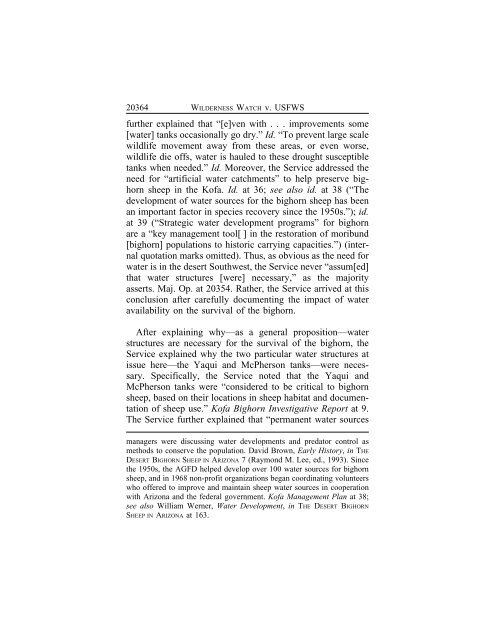WILDERNESS WATCH v. USFWS - Ninth Circuit Court of Appeals
WILDERNESS WATCH v. USFWS - Ninth Circuit Court of Appeals
WILDERNESS WATCH v. USFWS - Ninth Circuit Court of Appeals
You also want an ePaper? Increase the reach of your titles
YUMPU automatically turns print PDFs into web optimized ePapers that Google loves.
20364 <strong>WILDERNESS</strong> <strong>WATCH</strong> v. <strong>USFWS</strong><br />
further explained that “[e]ven with . . . improvements some<br />
[water] tanks occasionally go dry.” Id. “To prevent large scale<br />
wildlife movement away from these areas, or even worse,<br />
wildlife die <strong>of</strong>fs, water is hauled to these drought susceptible<br />
tanks when needed.” Id. Moreover, the Service addressed the<br />
need for “artificial water catchments” to help preserve bighorn<br />
sheep in the K<strong>of</strong>a. Id. at 36; see also id. at 38 (“The<br />
development <strong>of</strong> water sources for the bighorn sheep has been<br />
an important factor in species recovery since the 1950s.”); id.<br />
at 39 (“Strategic water development programs” for bighorn<br />
are a “key management tool[ ] in the restoration <strong>of</strong> moribund<br />
[bighorn] populations to historic carrying capacities.”) (internal<br />
quotation marks omitted). Thus, as obvious as the need for<br />
water is in the desert Southwest, the Service never “assum[ed]<br />
that water structures [were] necessary,” as the majority<br />
asserts. Maj. Op. at 20354. Rather, the Service arrived at this<br />
conclusion after carefully documenting the impact <strong>of</strong> water<br />
availability on the survival <strong>of</strong> the bighorn.<br />
After explaining why—as a general proposition—water<br />
structures are necessary for the survival <strong>of</strong> the bighorn, the<br />
Service explained why the two particular water structures at<br />
issue here—the Yaqui and McPherson tanks—were necessary.<br />
Specifically, the Service noted that the Yaqui and<br />
McPherson tanks were “considered to be critical to bighorn<br />
sheep, based on their locations in sheep habitat and documentation<br />
<strong>of</strong> sheep use.” K<strong>of</strong>a Bighorn Investigative Report at 9.<br />
The Service further explained that “permanent water sources<br />
managers were discussing water developments and predator control as<br />
methods to conserve the population. David Brown, Early History, in THE<br />
DESERT BIGHORN SHEEP IN ARIZONA 7 (Raymond M. Lee, ed., 1993). Since<br />
the 1950s, the AGFD helped develop over 100 water sources for bighorn<br />
sheep, and in 1968 non-pr<strong>of</strong>it organizations began coordinating volunteers<br />
who <strong>of</strong>fered to improve and maintain sheep water sources in cooperation<br />
with Arizona and the federal government. K<strong>of</strong>a Management Plan at 38;<br />
see also William Werner, Water Development, in THE DESERT BIGHORN<br />
SHEEP IN ARIZONA at 163.

















